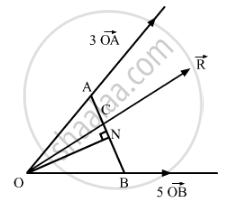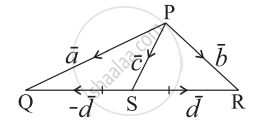Advertisements
Advertisements
प्रश्न
Forces 3 O \[\vec{A}\], 5 O \[\vec{B}\] act along OA and OB. If their resultant passes through C on AB, then
विकल्प
C is a mid-point of AB
C divides AB in the ratio 2 : 1
3 AC = 5 CB
2 AC = 3 CB
उत्तर
3 AC = 5 CB
Draw ON, the perpendicular to the line AB
Let
\[\vec{i}\] be the unit vector along ON
The resultant force \[\vec{R} = 3 \overrightarrow{OA} + 5 \overrightarrow{OB} . . . . . \left( 1 \right)\]
The angles between \[\vec{i}\] and the forces \[\vec{R} , 3 \overrightarrow{OA} , 5 \overrightarrow{OB}\] are ∠CON, ∠AON, ∠BON respectively.
\[\vec{R} \cdot \vec{i} = 3 \overrightarrow{OA} \cdot \vec{i} + 5 \overrightarrow{OB} \cdot \vec{i}\]
⇒ R⋅1⋅ cos ∠CON = 3
\[\overrightarrow{OA}\]⋅1⋅cos∠AON + 5
\[\overrightarrow{OB}\]⋅1⋅cos∠BON
\[R \cdot \frac{ON}{OC} = 3OA \times \frac{ON}{OA} + 5OB\frac{ON}{OB}\]
\[\frac{R}{OC} = \left( 3 + 5 \right)\]
R = 8
\[\overrightarrow{OC}\]
We know that,
\[\overrightarrow{OA} = \overrightarrow{OC} + \overrightarrow{CA} \]
\[ \Rightarrow 3 \overrightarrow{OA} = 3 \overrightarrow{OC} + 3 \overrightarrow{CA} . . . . . \left( i \right)\]
\[ \overrightarrow{OB} = \overrightarrow{OC} + \overrightarrow{CB} \]
\[ \Rightarrow 5 \overrightarrow{OB} = 5 \overrightarrow{OC} + 5 \overrightarrow{CB} . . . . . \left( ii \right)\]
on adding (i) and (ii) we get,
\[3 \overrightarrow{OA} + 5 \overrightarrow{OB} = 8 \overrightarrow{OC} + 3 \overrightarrow{CA} + 5 \overrightarrow{CB} \]
\[\vec{R} = 8 \overrightarrow{OC} + 3 \overrightarrow{CA} + 5 \overrightarrow{CB} \]
\[8 \overrightarrow{OC} = 8 \overrightarrow{OC} + 3 \overrightarrow{CA} + 5 \overrightarrow{CB}\]
\[\left| 3 \overrightarrow{AC} \right| = \left| 5 \overrightarrow{CB} \right|\]
\[ \Rightarrow 3AC = 5CB\]
APPEARS IN
संबंधित प्रश्न
If \[\vec{a}\] and \[\vec{b}\] represent two adjacent sides of a parallelogram, then write vectors representing its diagonals.
If \[\overrightarrow{a}\] is a non-zero vector of modulus a and m is a non-zero scalar such that m \[\overrightarrow{a}\] is a unit vector, write the value of m.
Write a unit vector making equal acute angles with the coordinates axes.
If \[\overrightarrow{a} = x \hat{i} + 2 \hat{j} - z \hat{k}\text{ and }\overrightarrow{b} = 3 \hat{i} - y \hat{j} + \hat{k}\] are two equal vectors, then write the value of x + y + z.
Write a unit vector in the direction of the sum of the vectors \[\overrightarrow{a} = 2 \hat{i} + 2 \hat{j} - 5 \hat{k}\] and \[\overrightarrow{b} = 2 \hat{i} + \hat{j} - 7 \hat{k}\].
Find the value of 'p' for which the vectors \[3 \hat{i} + 2 \hat{j} + 9 \hat{k}\] and \[\hat{i} - 2p \hat{j} + 3 \hat{k}\] are parallel.
If \[\left| \overrightarrow{a} \right| = 4\] and \[- 3 \leq \lambda \leq 2\], then write the range of \[\left| \lambda \vec{a} \right|\].
If \[\vec{a} , \vec{b}\] are the vectors forming consecutive sides of a regular hexagon ABCDEF, then the vector representing side CD is
The vector equation of the plane passing through \[\vec{a} , \vec{b} , \vec{c} ,\text{ is }\vec{r} = \alpha \vec{a} + \beta \vec{b} + \gamma \vec{c} ,\] provided that
The vector `bar"a"` is directed due north and `|bar"a"|` = 24. The vector `bar"b"` is directed due west and `|bar"b"| = 7`. Find `|bar"a" + bar"b"|`.
In the given figure express `bar"c"` and `bar"d"` in terms of `bar"a"` and `bar"b"`.

Express `- hat"i" - 3hat"j" + 4hat"k"` as the linear combination of the vectors `2hat"i" + hat"j" - 4hat"k", 2hat"i" - hat"j" + 3hat"k"` and `3hat"i" + hat"j" - 2hat"k"`
Select the correct option from the given alternatives:
The volume of tetrahedron whose vectices are (1,-6,10), (-1, -3, 7), (5, -1, λ) and (7, -4, 7) is 11 cu units, then the value of λ is
Select the correct option from the given alternatives:
If `|bar"a"| = 3` and - 1 ≤ k ≤ 2, then `|"k"bar"a"|` lies in the interval
Select the correct option from the given alternatives:
Let a, b, c be distinct non-negative numbers. If the vectors `"a"hat"i" + "a"hat"j" + "c"hat"k" , hat"i" + hat"k" "and" "c"hat"i" + "c"hat"j" + "b"hat"k"` lie in a plane, then c is
Find the lengths of the sides of the triangle and also determine the type of a triangle:
A(2, -1, 0), B(4, 1, 1), C(4, -5, 4)
Find the unit vectors that are parallel to the tangent line to the parabola y = x2 at the point (2, 4).
If ABC is a triangle whose orthocentre is P and the circumcentre is Q, prove that `bar"PA" + bar"PB" + bar"PC" = 2bar"PQ".`
Find the acute angle between the curves at their points of intersection, y = x2, y = x3.
Find the angle between the lines whose direction cosines are given by the equations 6mn - 2nl + 5lm = 0, 3l + m + 5n = 0.
State whether the expression is meaningful. If not, explain why? If so, state whether it is a vector or a scalar:
`|bar"a"|. (bar"b" + bar"c")`
If `overline"u"` and `overline"v"` are unit vectors and θ is the acute angle between them, then `2overline"u" xx 3overline"v"` is a unit vector for ______
If A, B, C and D are (3, 7, 4), (5, -2, - 3), (- 4, 5, 6) and(1, 2, 3) respectively, then the volume of the parallelopiped with AB, AC and AD as the co-terminus edges, is ______ cubic units.
a and b are non-collinear vectors. If c = (x - 2)a + b and d = (2x + 1)a - b are collinear vectors, then the value of x = ______.
If `veca` and `vecb` are unit vectors, then what is the angle between `veca` and `vecb` for `sqrt(3) veca - vecb` to be a unit vector?
If `vec"a", vec"b", vec"c"` determine the vertices of a triangle, show that `1/2[vec"b" xx vec"c" + vec"c" xx vec"a" + vec"a" xx vec"b"]` gives the vector area of the triangle. Hence deduce the condition that the three points `vec"a", vec"b", vec"c"` are collinear. Also find the unit vector normal to the plane of the triangle.
The vector `vec"a" + vec"b"` bisects the angle between the non-collinear vectors `vec"a"` and `vec"b"` if ______.
Classify the following as scalar and vector quantity.
Distance
Let `veca, vecb` and `vecc` be three unit vectors such that `veca xx (vecb xx vecc) = sqrt(3)/2 (vecb + vecc)`. If `vecb` is not parallel to `vecc`, then the angle between `veca` and `vecc` is
Let the vectors `vec(a)` such `vec(b)` that `|veca|` = 3 and `|vecb| = sqrt(2)/3`, then `veca xx vecb` is a unit vector if the angle between `veca` and `vecb` is
If `veca = hati - hatj + 7hatk` and `vecb = 5hati - hatj + λhatk`, then find the value of λ so that the vectors `veca + vecb` and `veca - vecb` are orthogonal.
Find `|vecx|` if `(vecx - veca).(vecx + veca)` = 12, where `veca` is a unit vector.
If points P(4, 5, x), Q(3, y, 4) and R(5, 8, 0) are collinear, then the value of x + y is ______.
In the triangle PQR, `bar(PQ) = 2bara` and `bar(QR)=2barb`. The mid-point of PR is M. Find following vectors in terms of `bar a and bar b `.
- `bar("PR")`
- `bar("PM")`
- `bar("QM")`
Find the value of λ for which the points (6, – 1, 2), (8, – 7, λ) and (5, 2, 4) are collinear.
In the triangle PQR, `bar(PQ)` = 2`bara` and `bar(QR)` = 2`barb`. The mid-point of PR is M. Find following vectors in terms of `bara` and `barb`.
- `bar(PR)`
- `bar(PM)`
- `bar(QM)`
Check whether the vectors `2hati + 2hatj + 3hatk, -3hati + 3hatj + 2hatk and 3hati + 4hatk` form a triangle or not.
Check whether the vectors `2 hati+2 hatj+3 hatk,-3 hati+3 hatj+2 hatk and 3 hati +4 hatk` form a triangle or not.
